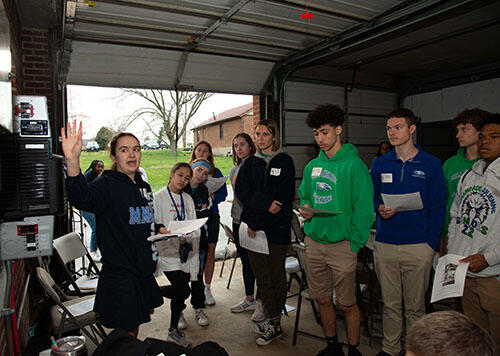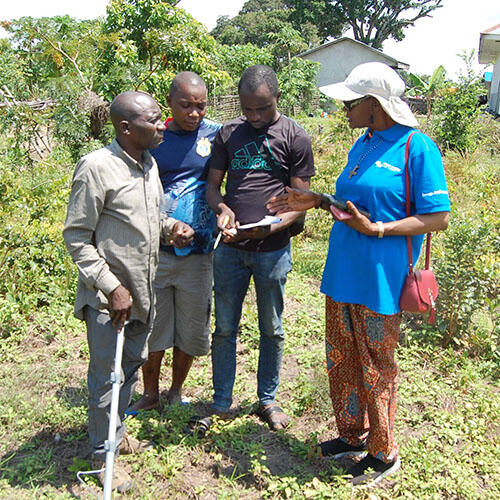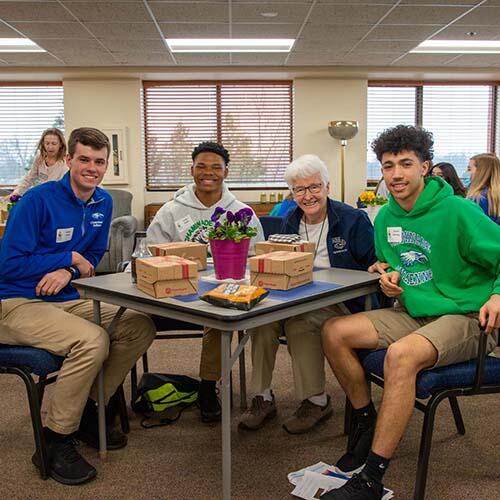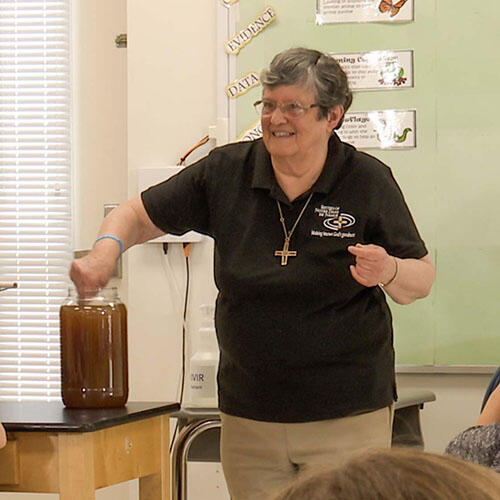
On April 5, 2022, students from Mount Notre Dame High School (Cincinnati) and Chaminade-Julienne High School (Dayton) attended a presentation given by Louis Casey at the Sisters' Photovoltaic Learning Lab in Cincinnati.
The Village of Pelende, in the Democratic Republic of Congo, is about to get water.
This is a big deal.
It means better health, it means more children in school, it means hope can once more fill the hearts of its five thousand residents.
The Sisters of Notre Dame de Namur have for years pushed infrastructure development. They have done this individually and as a congregational priority. Such development has had many fronts, among them fundraising, education, engineering, and boots on the ground. And while one or more fronts may have at intervals suffered setbacks, such as in the depths of COVID, other fronts have pushed forward, relentlessly so. And now, in Pelende, the battle is nearly won.
 |
| Students at the Sisters of Notre Dame de Namur school in Pelende will now have electricity, clean water and internet access at their school. |
Pelende is in some ways similar to other of the Sisters’ 16 development projects in the Democratic Republic of Congo (DRC) and Nigeria — and in some ways different. The similarities mostly relate to need. Without readily available clean water, disease is far more prevalent, education is hindered in that children are out of the classroom (in pursuit of water), adolescent girls drop out of school because of a lack of sanitation, women and men who otherwise might contribute to economic development instead are consumed with the daily trek to the waterhole or stream; the list goes on. And Pelende has experienced all of this. Yet, Pelende is different as well. Its older residents remember when clean water flowed through a system constructed by the Jesuits in the 1950s and 60s. They remember the promise of such water, and how it changed daily life.
From the Beginning
Water, or the lack of it, has a long history in Pelende, a history that involves the resolve of its residents, Jesuits, French consultants, an American engineer, Midwestern benefactors, Cincinnati high school students and school children, many still in grammar school. Especially crucial have been Sisters of Notre Dame de Namur. Sisters have worked in Pelende and other DRC villages as teachers and healthcare providers. They’ve worked at the provincial level coordinating electricity, water and satellite communications projects, including in Pelende. And they’ve worked in congregational leadership from the United States to Rome providing financial support. Importantly, Sisters have worked from Mount Notre Dame in Cincinnati raising funds, testing technology and spreading the word about clean water.
Technology in particular received greater emphasis beginning with a 2002 congregation-wide meeting of the Sisters, at which it was decided all Sisters, no matter their location, would be provided equal access to technology with the understanding that such access would by extension benefit the communities in which they ministered. This access would be provided whether Sisters lived in economically affluent nations, such as the United States, or in post-colonial and still developing nations, such as the DRC. The decision meant a reallocation of resources, both capital and human, much as a reallocation of resources from Europe to America enabled American provinces to build schools from California to Massachusetts. It also meant a reallocation of the congregational leadership’s attention, with increased focus on those provinces near the equator. The 2002 decision had a dramatic impact on the Sisters’ work in the DRC, no more so than in Pelende.
Pelende is two days rough ride from the national capital of Kinshasa. In many ways, it’s emblematic of the larger country. In the DRC, life spans are short — just over 60 years. Nearly 90 percent of its workforce is without regular employment. Most people get by on a couple dollars a day. The country has endured decades of political strife and war, some local, some continent-wide.
 |
| The maternity hospital in Pelende will now have clean, potable water alongside electricity. |
Through it all, and since 1894, the Sisters have remained in-country. They run primary and secondary schools in Pelende that together serve 1,000 students and boarders, and also operate a hospital. In the early 2000s, and growing out of the 2002 congregational meeting, they began installation of a photovoltaic system providing the village with electricity. Yet clean water, but for a brief period, has proven elusive. The Jesuits made the first attempt in 1956, the infrastructure for which, in the form of large holding tanks, still exists. But within a 20-year-period, for lack of maintenance and in tandem with other infrastructure decay throughout the country, the system began to run dry.
Sister of Notre Dame de Namur Margaret Goode, a teacher during that time, saw those unused tanks day in and day out. She saw the children snaking down the hill to the spring, and an hour later snaking up again. She saw the water buckets on their heads, the hours of lost time, the forfeiture of human potential. And for 40 years she let people know about it. Even as civil war spilled over from Rwanda, she pushed for a renewal of the water infrastructure. No meaningful progress could be made, she believed, unless there was water. “Sister Margaret nearly lost her mind trying to get a resolution,” says United Kingdom-based Louis Casey, Sisters of Notre Dame de Namur engineer for the Africa Clean Water Project. “There was an overall acceptance on the part of society that things were disintegrating.” Mr. Casey’s arrival in 2007 and Sister Margaret’s departure a few years later provided the needed overlap to begin improvements. In 2010 the photovoltaic system was completed on the convent roof to establish an independent electrical system, one that could turn on the lights, provide refrigeration, and importantly — one that could move and purify water.
 |
| Louis Casey, project engineer for the Sisters' Africa Clean Water Project, poses with Pelende villagers who will benefit from the renovated water system this fall. |
Three years later a French water company provided a scope of work and cost estimate for a new water system. Simultaneously, other groundwork began to take shape. Casey was on-site in Pelende and in other African villages. Fundraising began, both by the Sisters and the Jesuits. And in Cincinnati, the Sisters constructed a Learning Lab at their Mount Notre Dame Convent for students and engineers to preflight technology for power generation and water purification, power and purification that would have to work and survive in equatorial conditions, and that could be maintained and repaired by local technicians. The Sisters also reached out to friends and former students whose expertise and professional connections could advance the effort. Jane and Glenn Bullock, friends of the Sisters who own a water filtration system used by a major American restaurant chain, volunteered their system for Africa. Another individual offered to purchase the heavy hydraulic pumps necessary to lift 19,000 gallons of water over 600 feet — each day — and to transport that same volume a mile distant.
Then Came COVID
 |
| Mount Notre Dame High School students explain the componens of the photovoltaic system to Chaminade-Julienne High School students at the Photovoltaic Learning Lab on April 5, 2022. |
Nevertheless, restoration of the system did not prove easy. Progress hit high hurdles. Sourcing of equipment. The cost of that equipment. Lack of vehicles to move that equipment. Nearly non-existent roads on which those vehicles and equipment had to transit. Then came COVID. Though still moving forward in America, in the DRC the Pelende project came to a halt. A year later, the Jesuits, unable to successfully secure their share of the project’s funding, reluctantly pulled out. “That’s when we had to make the decision,” says Casey. “Do the Sisters do this by themselves? And it was decided, yes they will.” The system, says Casey, will differ from other African water systems built by the Sisters in that water will first flow to the village with a connection then coming off the primary piping to service the Sisters’ needs.
“We’re actually doing two systems, the village system, and connected to it, the Sisters.” Water will also flow to the Jesuit school. Such an arrangement serving different constituencies, each having large numbers of people, will necessitate a kind of water company to handle varying degrees of filtration and purification, to assess usage fees, to handle maintenance, etc. This ongoing business end of the project will itself present a challenge because of cultural differences involving the distribution of resources, with some believing that water belongs to everyone and therefore should be free. “These issues are intricate,” says Casey, “and part and parcel in engaging in development in these communities.”
 |
| Sister Dorothy Moya (right) and electrical contractor Jimmy Abeya (second from right) and his staff discuss the plans for renovating the Pelende water system. |
The Pelende project also differs from many of the Sisters’ other water projects in that water will come from an existing spring instead of via a borehole, water that according to Casey is already high quality. Swiss-manufactured pumps will then use the kinetic energy of the stream to lift the water, without the use of electricity. (Electricity will later be used to purify the water and move it to various locations.) “The beauty of these things [pumps] is that they produce a very high pressure, 300 pounds per square inch. You can’t just go out and buy these things.” The Pelende project will move its first water in November 2022. ‘Long-lead’ items, those components of the project taking the most time to secure, are in place or in transit. Active procurement for other items is proceeding at pace, with many such items bought from a local network of vendors and contractors. This local sourcing of materials and services has been a priority for the Sisters in that they seek not only to reduce supply-chain times, but to promote local and regional economic development.
Piping for the system will include water that is filtered and potable alongside untreated water to be used for things other than drinking, cooking and bathing. A project-designated vehicle has also been purchased to ease transportation. Perhaps most importantly, day-to-day oversight of the project has been shifted from the international congregation to the local Sisters of Notre Dame de Namur province in the DRC, with Congolese Sister Dorothée Moya — long familiar with the sites and with hands-on knowledge of the equipment — in charge not only of Pelende but other DRC sites where photovoltaic electricity and clean water have been or are currently being introduced.
Solidarity
 |
| As part of their visit to the Photovoltaic Learning Lab in Cincinnati, Chaminade-Julienne High School students share lunch and conversation with Sister Jo Ann Depweg who served in Brazil for 30 years. |
In addition to engineering and testing through the Learning Lab in the United States, and onsite in Africa, and in addition to fundraising, the Sisters have sought to build solidarity with, and understanding of, those marginalized by a lack of clean water. Through visits and presentations, the Sisters have built partnerships with over 80 schools, parishes and parish groups, that these organizations can push to the forefront the imperative of clean water, and advance as well a general and increased consciousness of those living on a daily basis without it. Key to this success has been the educational work of Sister Ann Fanella and other Sisters of Notre Dame de Namur who travel to classrooms in Cincinnati and throughout the country. These Sisters, while speaking directly to students, are by extension spreading the word to teachers and administrators as well as to parents. And while countries such as the DRC and Nigeria are mentioned, it’s the children-to-children connection that hits home. Sister Ann will, for example, hold up a glass of water and say, “This is what we drink.”
Then she’ll add a tablespoon of dirt. “The children in Africa, this is what they drink.”
Then she says how far it is just to get that water, and how long it takes — on foot and with a bucket on your head. And how long it takes to search out firewood to later boil that water.
 |
| Sister Ann Fanella demonstrates the cleaning powers of the P&G water purification packets to students at Summit Country Day School in Cincinnati. |
The children — and the teachers and administrators and parents — understand. And they act. Not only do they have a new understanding of the difficulties faced by others, they also work to do their part in relieving those difficulties — through school fundraising. It’s pennies, nickels and dimes from the younger students, more from the older students, and even more from parents. Sometimes it adds upto $100, sometimes $1,000. But whatever the amount, it directly benefits people in need an ocean away. It’s concrete support, and it’s solidarity.
Through Sister Ann, children and teachers and parents have become part of the Sisters of Notre Dame de Namur mission — to give people what they need for life.
And in Pelende, that means water!
Published in Cross Currents Magazine Summer 2022, Volume 18, Issue 2
